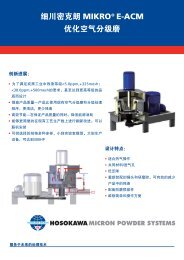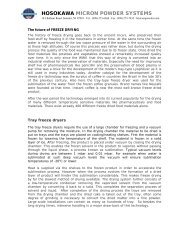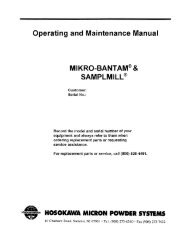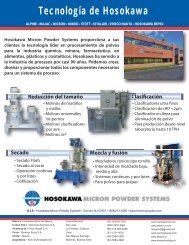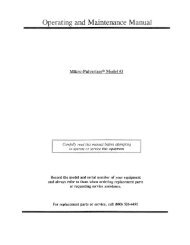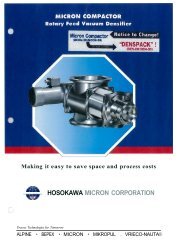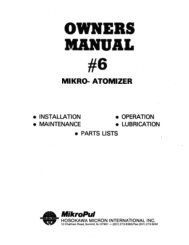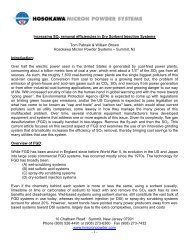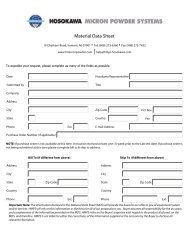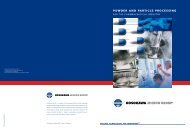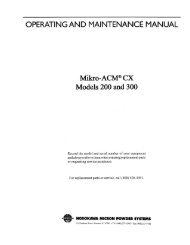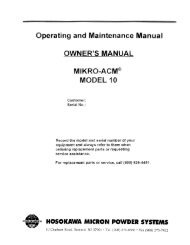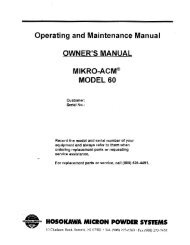Carbon black - Hosokawa Micron Powder Systems
Carbon black - Hosokawa Micron Powder Systems
Carbon black - Hosokawa Micron Powder Systems
You also want an ePaper? Increase the reach of your titles
YUMPU automatically turns print PDFs into web optimized ePapers that Google loves.
16 Rubber & Plastics News ● December 13, 2010 ww.rubbernews.comTechnical<strong>Carbon</strong> <strong>black</strong>: why quality mattersBy Tom Patnaik & Bill Brown<strong>Hosokawa</strong> <strong>Micron</strong> <strong>Powder</strong> <strong>Systems</strong><strong>Carbon</strong> <strong>black</strong> is virtually pure 97 percent-pluselemental carbon, constitutingthe vast bulk of material (called “filler”)in your car tire, as well as printing inks,coatings, and many other rubber andplastic products in use today.A top-50 industrial chemical withabout 10 million metric tons producedworldwide annually, carbon <strong>black</strong> findsits way into a myriad of different usesbased upon certain properties fixed atthe time of production and subsequentenhancement.<strong>Carbon</strong> <strong>black</strong> has been around forthousands of years, better known as“lamp <strong>black</strong>.” It has been produced duringthe burning of oil-lamps or candles,essentially the dark component ofsmoke.Over the last century, the ability ofcarbon <strong>black</strong>, used as a filler to significantlyenhance the property of any baseTECHNICAL NOTEBOOKEdited by Harold Herzlichhpolymer matrix (such as rubber used tomanufacture automotive tires) whilelowering its cost, became evident.With the growth of the automotiveindustry and the parallel growth ofplastics since World War II, the studyand use of carbon <strong>black</strong> took hold andgrew.Uses of carbon <strong>black</strong>With about 90 percent of carbon <strong>black</strong>used in rubber applications, more than80 percent is used in the automotiveTable I. Types of carbon <strong>black</strong> used in tires.Fig. 1 Furnace <strong>black</strong> process.Executive summaryAs automobile demand grows, and their performance continues to improve,the role of the material used in the manufacture of car tires has started to playa major factor in the comfort and safety aspects of automotive design.<strong>Carbon</strong> <strong>black</strong> is an additive in the rubber used to manufacture tires which,when compounded into the polymer matrix, significantly improves tensilestrength and abrasion resistance.Improved rubber chemistry and tire design are creating exciting new tiresthat offer ever greater mileage and performance under extreme weather conditions.However, the carbon <strong>black</strong> manufacturing operation also produces an impurityknown simply as “grit” which, since the average grit size is several timeslarger than the clustered carbon <strong>black</strong> particles, if left in there with the carbon<strong>black</strong> will significantly and adversely impact the tire manufacturing equipmentas well as the final quality of the tire.Reducing these grits using high-speed grinding mills, down to a size wherebythey are rendered harmless, is the focus of this paper.market alone, the vast bulk as “filler”for car tires that gives them their distinctive<strong>black</strong> color and imparts certaindesirable properties (outlined in TableI).Less than 20 percent finds use in nonautomotiveapplications such as in theproduction of printing ink, plastics,<strong>black</strong> mulch, etc.Because of the critical and overabundantrole it plays in the automotive tiresegment, several grades of carbon <strong>black</strong>have been developed to produce differenttire qualities, which in turn, commandpremium prices in the market.As polymers replace metal in automotivemanufacturing, and also as carspeeds, tire design and performancecontinue to improve, the demand notjust for any carbon <strong>black</strong>, but specialgrades of carbon <strong>black</strong>, continues togrow at a rate much faster than the restof the market.<strong>Carbon</strong> <strong>black</strong> is also used in manymolded and extruded industrial rubberproducts such as belts, hoses and gaskets,as well as vibration isolation pads,among a myriad of other components.<strong>Carbon</strong> <strong>black</strong> can also be found inplastics in conductive packaging, industrialtrash bags, household appliancesand blow-molded containers.It is also used to provide UV-protectionin a number of coating applicationsand in electrostatic discharge compounds.Because of its unique physical,chemical and electrical properties, carbon<strong>black</strong> use is sure to expand.How is carbon <strong>black</strong> produced?<strong>Carbon</strong> <strong>black</strong> is the product of incompletecombustion of a hydrocarbon.While there are about a half-dozenmanufacturing processes, just about allcarbon <strong>black</strong> in the world is produced byone of two methods: (a) the thermal<strong>black</strong> process, or (b) the furnace <strong>black</strong>process.Both processes involve essentially thesame steps, but the thermal <strong>black</strong>process uses natural gas as the feedstock,whereas the more prevalent furnace<strong>black</strong> process uses heavy aromaticoil as the feedstock.The feedstock is introduced as microdroplets(atomized) into an intensely hotcombustion chamber or reactor maintainedunder controlled conditions oftemperature and pressure, with the reactionrate being controlled by the injectionof water or steam.The feedstock pyrolyzes, producingcarbon <strong>black</strong> particles which are cooledand removed from the process gasstream using bag-filters, and may thenbe pelletized and bagged for transportation,or further processed to achieve certainqualities (see Fig. 1).The thermal <strong>black</strong> process using naturalgas uses two furnaces that alternateevery five minutes between pre-heatingand production, with the carbon <strong>black</strong>particles produced being then quenchedand captured in bag-filters, followed byfurther processing to remove impurities,pelletized, screened and packaged fortransportation.Studies have shown that a pure gumvulcanizate of styrene-butadiene (SBR,or synthetic rubber), which has a tensilestrength of less than 2.5 MPa with almostnon-existent abrasion resistance, ifcompounded with 50 percent by weightof carbon <strong>black</strong> has much higher tensilestrength and wear resistance (see TableI).Therefore, the carbon <strong>black</strong> gradechosen for a given compound can greatlyinfluence the properties of the compound,as well as have a large impacton the methods used to process thecompound.The two processes especially impactedby the carbon <strong>black</strong> grade are mixingand extrusion.Effective mixing or “dispersion” of thecarbon <strong>black</strong> in the polymer matrix isimportant, as mixing time can be a majorbottleneck in the tire manufacturingprocess.While larger particles produce gooddispersion relatively quickly, finer particlescan be difficult and may requiremore than one pass through the mixer.When the rubber stock is extrudedthrough a die, it exhibits “elastic memory,”a phenomenon that producesswelling.Fig. 3. Long gap mill.Fig. 2 Sequence of structure development.
www.rubbernews.comTechnicalRubber & Plastics News ● December 13, 2010 17<strong>Carbon</strong> <strong>black</strong> improves the extrusionproperties by inhibiting elastic memory,and this ability to reduce swelling is adirect function of increased surface areaand structure.However, presence of impurities,known as “grit,” can sharply reducescreen life as well as the life of the extrusiondie and other compoundingequipment used in the tire manufacturingprocess.<strong>Carbon</strong> <strong>black</strong> has four fundamentalproperties, in addition to being inexpensiveand relatively easy to produce,that makes it more than just simplefiller—it significantly enhances theproperties of the polymer matrix (rubber)system.These are:● particle size;● structure;● specific area (surface area per unitvolume); and● surface activity.The carbon <strong>black</strong> particle size is mostlyin the nanometer range (anywherefrom 8 to 100 nm) with particles oftenaggregating in grape-like clusters to 500nm.The quicker the reaction time, thesmaller the particles and better the finalproperties.But the combustion process, especiallyin the vertical furnace, also producescarbonaceous impurities known as gritthat are considerably larger than thecarbon <strong>black</strong> particles, and present certainchallenges when the carbon <strong>black</strong> isused as a filler in the polymer matrix inautomotive tires, and hence, the grithave to be either removed or ground fineor size-reduced.The effect of smaller particle size ofcarbon <strong>black</strong> in rubber is multi-fold,namely, increased tensile strength andabrasion resistance, reduced reboundand decreased dispersibility.The next two properties listed above,i.e., structure and specific area, impactgreatly the ability of the elastomer (inwhich the carbon <strong>black</strong> is mixed) to beFig. 4. Mikro-LGM flow pattern.Fig. 5. Air classifying mills.extruded during the manufacturingprocess, and as such, this is often the determiningcriteria for selection of highergrades of carbon <strong>black</strong> in automotivetire manufacturing.As mentioned above, the structure ofcarbon <strong>black</strong> especially as particle aggregates,act as short fibers in the polymermatrix, producing a stiffening effectthat inhibits elasticity and swelling.Finally, surface activity of carbon<strong>black</strong> is a little understood area thatgreatly affects the reinforcement potentialof carbon <strong>black</strong> in rubber.Suffice to say that surface activity isthe ability of carbon <strong>black</strong> surface to immobilizethe polymer, and greater surfaceactivity of carbon <strong>black</strong> in rubberproduces increased abrasion resistance,rebound and modulus.The authorsTom Patnaik and Bill Brown,both of <strong>Hosokawa</strong> <strong>Micron</strong> <strong>Powder</strong><strong>Systems</strong>, are accomplished individualsin the field of micronization(size-reduction) of powders.They bring their technicalknowledge and decades of powderprocessing expertise to many industries,including chemicals andminerals.Questions, comments or observationsmay be e-mailed to tpatnaik@hmps.hosokawa.comandbbrown@hmps.hosokawa.com.<strong>Hosokawa</strong> <strong>Micron</strong> <strong>Powder</strong> SystemUSA is a division of <strong>Hosokawa</strong><strong>Micron</strong> Corp. of Osaka, Japan, aworld leader in size-reduction,mixing, drying and other processequipment.Grit: impact and measurementGrit, as mentioned in the last section,is an impurity in carbon <strong>black</strong> and affectsthe polymer matrix into which thecarbon <strong>black</strong> is dispersed in much thesame manner as sand inclusions impactthe quality of metal castings.Grit significantly affects the tensilestrength and other mechanical propertiesof rubber.Additionally, its presence in carbon<strong>black</strong> impacts adversely the extrusionscreen life in automotive tire manufacturing.While a certain amount of grit up to acertain size may be accepted (dependingon what is agreed upon by producerand user), the grit has to be either removedor reduced sufficiently in size soas to become an integral part of the matrix.For automotive tires, while coarsergrit affects tensile strength and abrasionresistance, fine grit is generally notconsidered detrimental.The amount of grit present in a sampleof carbon <strong>black</strong> is measured bywashing a measured amount of the carbon<strong>black</strong> on a specified screen size, untilall of it is washed away and all thatremains on the screen is grit (ASTM1514).This insoluble residue, when driedand weighed, is expressed in mg/kg (orppm) of the original sample, as an indicationof the quality of the carbon<strong>black</strong>.The smaller the ppm, the greater theability of the carbon <strong>black</strong> to increasethe tensile strength and wear resistanceof the polymer it is dispersed in.As such, finer grinds of grit and carbon<strong>black</strong> not only expands the marketbut also allows that brand to move frombeing a commodity to more of a specialtyproduct, thereby being able to commanda price premium and a loyal clientele.Grit size-reductionBecause it has become more difficultfor carbon <strong>black</strong> manufacturers to competewith a stable of commodity productsand keep up with demand for a reduced-gritor fine-ground grit carbon<strong>black</strong> for the growing global automotivemarket, it has become not just necessarybut in many ways a matter of survivalfor carbon <strong>black</strong> manufacturers to installspecialized milling devices as partof their production process for grit andresidue control.Developing cleaner, near grit-free carbon<strong>black</strong> that adds strength, durabilityand enhanced performance to automotivetires, enables the carbon <strong>black</strong> manufacturerto differentiate itself in thiscompetitive market and command higherprices, generating more revenue andhigher profit margins.The milling technology that is prevalenttoday is unable to lower grit levelsbelow 100 PPM + 325 MESH for mostgrades with feed residues above 500PPM.Product quality is often measured interms of residues at +35 MESH and +325 MESH.However, there are milling systemssuch as air classifying mills (ACM) andlong gap mills (LGM) that are capable ofproducing < 5 PPM + 325 MESH and
18 Rubber & Plastics News ● December 13, 2010 ww.rubbernews.comBlackContinued from page 17etary eductor mechanism, developed toreturn rejected particles back to thestacked rotor assembly.By rejecting oversize particles externally,products with unprecedented lowresidue levels are realized.The LGM is designed to operate in hotprocess gas streams typically in therange of 100 to 200°C.In addition, the LGM can be installedin-line, downstream of the primary bagfilter(s).The in-line mill requires very littlefloor space, the need for additional ancillarycomponents, hence minimizing constructionand installation costs.The LGM is a leading technology forcarbon <strong>black</strong> grit reduction, producingthe cleanest, best quality product, capableof achieving as low as 1-2 PPM +500 MESH for most grades of carbon<strong>black</strong>.Those carbon <strong>black</strong> manufacturersseeking higher profit specialty applicationscan surely benefit by incorporatinga LGM into the process.Many domestic and internationalequipment manufacturers produce longgap mills.Air classifying millsFor those carbon <strong>black</strong> applicationsthat require a cleaner product, but notto the exacting standards of single-digitPPM of a +500 mesh grit, a less expensiveoption is an air classifying mill(ACM).Feed material dispersed in the primaryair stream from the bag filter ofthe reactor is routed under the impactrotor.The ACM rotor is equipped with specialplate hammers and a hybrid multipledeflector liner.The ACM also employs two mechanicalstressing mechanisms to reduce thesize of the particles.The primary stress mechanism is mechanicalimpact caused by the directTable II. Data from testing and current mill installations.contact of the hammers/beater bladesagainst the fluidized powder.The secondary force is particle-to-particleattrition caused by the vortices createdby the passing tip of the plate hammersin close proximity to the multipledeflector liner.The combined stressing mechanismaccounts for about 80-percent impact attritionand 20-percent attrition.Feed material dispersed in the primaryair stream from the bag filter ofthe reactor is routed under the impactrotor and is conveyed through a specificannular gap between the plate hammersand liner.The milled particles pass from thegrinding zone through the elongatedACM chamber to an independently drivenforced vortex air classifier.The dynamic integral classifier operatesat high tip speeds; oversize particlesare rejected by the classifier andexit the mill through a controlled outletgate.The ACM is equipped with a proprietaryeductor mechanism, developed toreturn rejected particles back to theprimary mill inlet/grinding zone.The combination of feeding from belowthe rotor disc and externally recyclingthe coarse particles improves thegrit reduction capability for low densitymaterials such as carbon <strong>black</strong>.Similarly, the ACM is designed to operatein hot process gas streams typicallyin the range of 100-200°C, and can beinstalled in-line, downstream of the primarybag filter(s).The in-line mill requires very littlefloor space, the need for additional ancillarycomponents, hence minimizing constructionand installation costs.The ACM is a considerable improvementfrom existing size reduction technologieswhether it is a hammer andscreen mill or other type of mechanicalimpact mill with integral classifier.The ACM has a proven track record,successfully replacing other millingtechnologies and achieving grit levels aslow as 1-2 PPM + 500 MESH for somegrades of carbon <strong>black</strong>.Many domestic and internationalTechnicalequipment manufacturers also produceair-classifying mills.Typical performance: grit reductionIn general, the performance of themill, whether it is the LGM or ACM, isdependent upon the level of grit andtype of grit in the feed material.Therefore, it is imperative that confirmationtrials are performed on a pilotsize mill to establish milling parameters,product quality data and capacityfigures.Table II shows a combination of actualdata from both testing and currentmill installations.Process integrationEither mill can be installed either offlinewith dedicated conveying and pneumaticancillaries or in-line after the reactorbag filter(s).If installed in-line, the LGM or ACMcan be sized to meet the capacity of thegrade(s) of carbon <strong>black</strong> to be processed.The size of the LGM or ACM can be determinedfrom testing.Often a particular grade of carbon<strong>black</strong> is conveyed from the bag filter at aspecified air to carbon <strong>black</strong> ratio, typicallyin the range of 40:1 to 50:1 poundsof carbon <strong>black</strong> per standard cubic footof air volume (lb:SCF).Both mills can be configured to meetthe criteria and produce the grades tothe desired specifications.Typical capacities range from 200kg/h to about 7.5 t/h depending on thegrade of carbon <strong>black</strong> and desired endproduct quality.<strong>Hosokawa</strong> offers the ACM from a 10HP pilot size mill at a nominal air flowrate of 500 SCFM up to a 300 HP mill ata nominal air flow rate of 15,000 SCFM.The LGM ranges from pilot size (30HP rotor/600 SCFM nominal air volume)up to a model with a 300 HP rotorat a nominal air volume of about 10,000SCFM.It is important to note that in a comparisonbetween the LGM and ACM, theLGM in almost every case tested producesa cleaner (lower grit level) productversus the ACM with improved screenlife.However, the improvement in productquality can be realized with theLGM but at higher energy consumption.The stacked rotor assembly combinedwith narrow clearances between thehammer plates and liner of the LGMcontribute to a higher pressure drop ascompared to that of the ACM.The LGM requires higher pressureconveying blowers to handle the highermill differential pressure, thus largerTable III. <strong>Carbon</strong> <strong>black</strong> price trends.motors consuming more electrical energy.Is the increased cost to produce ahigher quality grade of carbon <strong>black</strong> usingthe LGM worth it? The selection dependson the potential market price ofthe value-added product.Summary and conclusionAs the number of automobiles worldwidecontinue to increase, and their performancecontinue to improve, carbon<strong>black</strong> promises to play a bigger role andannual production of this industrialchemical is almost sure to continuetracking gains in rubber demand.However, the presence of grit and otherimpurities will also require greaterattention and test the carbon <strong>black</strong>manufacturer’s ability to manage if noteliminate its presence in the final product.The manufacturer that is successfulin doing so will almost certainly commandgreater customer loyalty, expandedmarket presence—and of course, premiumpricing.Historically, over time, the finer SuperAbrasion N110 grade of carbon<strong>black</strong> has seen significant demand—and therefore price—increase, comparedto the coarser general purposegrades.In addition, the finer grades of carbon<strong>black</strong> enjoy smaller price elasticity ofdemand, in the range of -0.8 or lower,meaning that a single unit of price increasedoes not impact demand asmuch, allowing manufacturers that focuson finer grades to not only commandbetter margins, but also demandfluctuation for their carbon <strong>black</strong> isminimized.Both types of mills described, theLGM and ACM, are cost effective methodsto manage an intractable problem,while presenting several advantagesover the conventional mills in use, including:● Greater capacity available from asingle machine● Can be retrofitted in-line in an existingprocess● Produces a much finer product andbe able to command premium pricing● Versatile and flexible; either millcan be adjusted to handle variousgrades of carbon <strong>black</strong>● Production of a value-added productto satisfy the demands in a niche marketat higher sale price and higher profitmargin.Being able to see this, and make thechanges necessary to implement it, willset apart the winners from the others inthe highly competitive world of carbon<strong>black</strong> manufacturing.Fig. 7. <strong>Carbon</strong> <strong>black</strong> pulverizer system Mikro-LGM long gap mill.




